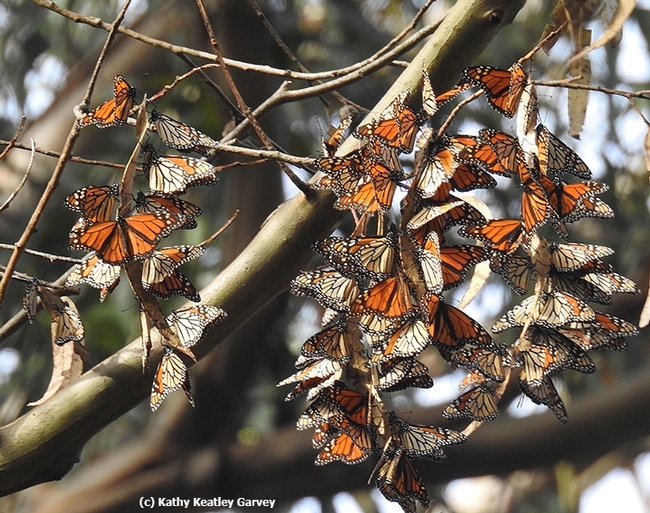
This just in from entomologist and migratory monarch researcher David James, an associate professor at Washington State University, who maintains a Facebook page, "Monarch Butterflies in the Pacific Northwest":
"October gave us mostly good weather in the PNW for monarchs migrating south and the last one was seen in Washington just a few days ago (26th). Sadly though, the number of sightings (17) was way down from October 2023 (40). This follows the downward spiral of the number of monarch sightings that I first reported in August. In June and July, numbers were up by nearly 70%! Curiously, something happened during the development of eggs, larvae and pupae of the migratory generation that reduced the population substantially. The number of sightings was down by 34% in August, 48% in September and 42% in October, compared to the respective months in 2023."
"While high temperatures occurred in many parts of the PNW in August," James shared, "they were not as high as in July when monarch sightings were common. PNW summer temperatures this year were not as high or as prolonged as during the heat dome event in late June 2021 which had no discernible impact on monarch sightings or the 2021/22 overwintering number which was substantially higher than the previous winter. Instead of climate, my guess is that the natural enemy community (or part of it) affecting immature stages of monarchs had a very favorable summer and caused greater than normal mortality to the monarch population."
On Oct. 1, James predicted an overwintering population in California of 112,000, half of the total in 2023. "I now believe the number this winter will be below 100,000, perhaps back to the levels we saw in 2018 and 2019 (around 30,000 butterflies). This will be disappointing for sure, but we know how resilient the monarch is and we know there will be a rebound in the future."
He mentioned that a tagged male monarch released Sept. 7 from the Elkton Community Education Center in southern Oregon was found Oct. 17 nectaring in Santa Barbara, "a record so far this year for the longest distance flown....over 38 days, this monarch flew a remarkable 670 miles! Not a record migration flight for a western monarch (that goes to a monarch that flew 840 miles from Seattle to Pismo Beach in 2017), but highly impressive, nevertheless. Not least for being able to avoid or overcome all the hazards it no doubt met en route. Think traffic, predators, pesticides and bad weather. H2864 is a survivor, at least so far. He still has the winter to endure of course but he is off to a flying start! Thanks to Elkton CEC for rearing another tough monarch and to Joe Brazil for reporting it and taking the photos."
We remember the WSU-tagged monarch that fluttered into our garden in Vacaville,Calif., from Ashland, Ore., on Sept. 5, 2016. Citizen scientist Steven Johnson of Ashland, Ore. tagged it A6093 on Aug. 28.
"So, assuming it didn't travel much on the day you saw it, it flew 285 miles in 7 days or about 40.7 miles per day," James told us. "Clearly this male is on his way to an overwintering colony and it's possible we may sight him again during the winter in Santa Cruz or Pacific Grove!”
They didn't.
However, migratory monarchs continue to stop for flight fuel on our Tithonia every year, usually from late August through September and October. Sometimes we see two or three a day. How many tagged ones since 2016? Zero. Zilch. Nada.
James' tagging program research, launched in 2012, confirms that most of the PNW monarchs migrate to the California coast for overwintering. "However, we have occasionally had evidence that migrating monarchs in eastern parts of the PNW (e.g. far eastern Washington and Idaho) do not always head southwest to California," he wrote. "Our latest tag recovery is an example of this. A monarch tagged on September 21 virtually on the state border between WA and ID near Spokane, was found on October 15 in the mountain town of West Yellowstone in Montana. This is 373 miles southeast from where the butterfly was released and she was clearly not looking to spend her winter on the California coast!
"Other tagged monarchs from far eastern areas of the PNW have also traveled southeast but this is the first one found in the Rocky Mountains at almost 7000 feet," he pointed out. "We assumed migrants southeast from Idaho would fly south down the western side of the Rockies, but this one looks like it was trying to cross them. Sadly, this one was found dead but she has contributed another data point to our efforts to unravel this migration mystery. We suspect that these SE-orienting migrants may end up in Mexico. Hopefully, future recoveries of tagged monarchs from Idaho will help us answer this question. We thank Patrick Adair for spear-heading the tagging efforts in Idaho and working tirelessly for monarchs and their conservation through his non-profit Wings Rising Inc. We also thank Peggie Scott for finding the butterfly and taking the photograph."
Wings up.
Attached Images:
